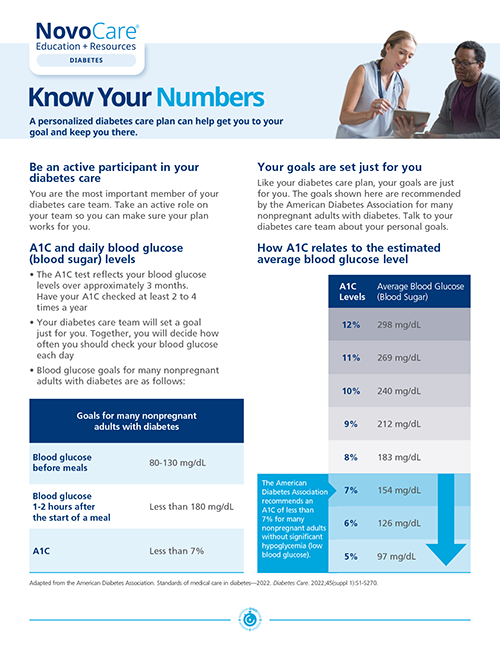
STAYING ON TRACK
A1C vs blood glucose: What are we looking at?

Find out how both blood tests give important insights into your health.
Checking your blood glucose and tracking your numbers is an important part of your diabetes care plan. Both your A1CA1CA test that gives you a picture of your average blood glucose level over the past 2 to 3 months. The results can give you an idea of how well your diabetes is being controlled. Also known as "hemoglobin A1C," the A1C test does this by measuring the amount of glucose that has attached to the hemoglobin in your red blood cells. More glucose means a higher A1C. and your blood glucoseBlood glucoseThe main sugar found in the blood, and the body’s main source of energy. levels show how well you’re managing your diabetes. But what’s the difference between these two tests?
Measuring blood glucose
Measuring your blood glucose can show how well your diabetes is controlled from one day to the next. It’s something you can do at home. This test can:

- Show you how well your medicines are working
- Show how physical activity and the foods you eat affect your blood glucose
- Help you avoid low blood glucose (hypoglycemia) and high blood glucose (hyperglycemia)
- Help you see the changes in your blood glucose and can help you better understand how physical activity, your diet, and stress affect blood glucose levels
Measuring A1C levels
The A1C test gives the big picture when it comes to your blood glucose. It shows how well you’re controlling your blood glucose over time by measuring the average blood glucose over the past 2 to 3 months. It’s like a “memory” of your blood glucose levels. This is a test you’ll have done at your doctor’s office.
How do A1C levels relate to average blood glucose levels?
When you get your A1C result, you may see a blood glucose reading next to it. This is another way of showing your average blood glucose levels using the same measurement that you see on your meter, mg/dL (milligrams per deciliter).
A1C = Average Blood Sugar Levels for the Past 2-3 Months
| A1C (%) | ESTIMATED AVERAGE GLUCOSE (mg/dL) |
|---|---|
| 12 | 298 |
| 11 | 269 |
| 10 | 240 |
| 9 | 212 |
| 9 | 183 |
| 7 | 154 |
| 6 | 126 |
Setting your blood glucose goals
These are the goals that the American Diabetes Association (ADA) recommends for adults with diabetes who are not pregnant. However, your doctor will personalize your plan and set goals that are right for you.
Blood Sugar and A1C Goals
| TIME | GOALS FOR ADULTS LIVING WITH DIABETES (nonpregnant) |
|---|---|
| Before meals | 80-130 mg/dL |
| 1-2 hours after starting a meal | Less than 180 mg/dL |
| A1C | Less than 7% |
How often should you check your blood glucose?
You and your health care professional will decide when and how often you should check your blood glucose. How diabetes affects the body is different for each person and changes over time. So, depending on what medicines you’re taking and your health care professional's directions, your blood glucose testing schedule may change.
You should ask your health care professional when you should call to discuss your blood glucose results. For example, they might say that you should call if your blood glucose levels are lower or higher than usual. Guidelines from the ADA recommend that people contact their doctor if:
- You have been sick for 1 or 2 days without getting better
- You are taking oral medicine and have a pre-meal blood glucose level that is 250 mg/dL or higher and stays high for over 24 hours, no matter when you test
Progress, not perfection
Remember that it’s almost impossible to keep your blood glucose at an ideal level all the time. From time to time, almost everyone with diabetes will experience either high blood glucose or low blood glucose.
Reviewing your blood glucose readings with your diabetes care teamDiabetes care teamYour diabetes care team may include a primary care doctor, a diabetes and hormone doctor (endocrinologist), a registered nurse, a diabetes educator, a dietitian, a heart doctor (cardiologist), a foot doctor (podiatrist), an eye doctor (ophthalmologist/optometrist), a kidney doctor (nephrologist), a dentist, a pharmacist, and a mental health professional. can help you find things that can cause your blood glucose to go too high or too low. That way, you can make the changes you need to stay on track!





